Three more things you need to know when transitioning from MCUs to FPGAs
Take a look at three more important difference between FPGAs and MCUs: "code reuse" vs templating, metastability and blocking vs. non-blocking operations.
Getting Started With Zephyr: Devicetree Bndings
This blog post shines some light on how devicetrees are used in The Zephyr Project. Specifically, we understand the mechanisms that enable us to use nodes in the devicetree in the C source files. We use a sample provided in the Zephyr repository itself and work our way through portions of the Zephyr codebase to get insight into the mechanisms that make this possible.
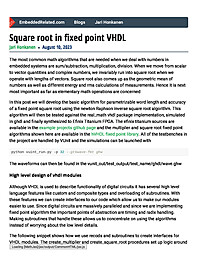
Square root in fixed point VHDL
We will design and implement a fixed point square root function in VHDL. The algorithm is based on the recursive inverse square root algorithm based on Newton Raphson and offers parametrizable pipeline depth, word length and the algorithm is built on records and procedures.
Quaternions and the spatial rotations in motion enabled wearable devices. Exploiting the potential of smart IMUs attitude estimation.
Have you always wondered what a quaternion is? this is your post. Attitude or spatial orientation analysis is a powerful element in wearable devices (and many other systems). Commercially available sensors can provide this information out-of-the-box without requiring complex additional implementation of sensor fusion algorithms. Since these are already on-chip solutions devices can serve as a way to explore and analyze motion in several use cases. Mathematical analysis for processing quaternion is presented along with a brief introduction to them, Although they are not really easy to visualise, a couple fairly simple examples are provided which may allow you to gain some intuition on what's the logic behind them.
From Embedded Software Engineer to Musician
In his first blog post on EmbeddedRelated, Jean Labrosse, the author of the uC/OS series and founder of Micrium, discusses his transition from an embedded software engineer to a musician.
Jumping from MCUs to FPGAs - 5 things you need to know
Are you a microcontroller expert beckoned by the siren song of the FPGA? Not long ago, that was me. FPGA-expert friends of mine regularly extolled the virtues of these mysterious components and I wanted in. When I made the leap, I found a world seemingly very familiar, but in reality, vastly different. I found that my years of C programming and microcontroller use often gave pre preconceived interpretations of FPGA resource material which resulted in eye-roll class mistakes in my code. I’ve gleaned five things of vital importance to help you make that transition faster than I did.
Assembly language is best - except when it isn’t
A look at why writing in C often produces more efficient code than hand-written assembly language.
C to C++: 5 Tips for Refactoring C Code into C++
The article titled "Simple Tips to Refactor C Code into C++: Improve Embedded Development" provides essential guidance for embedded developers transitioning from C to C++. The series covers fundamental details necessary for a seamless transition and emphasizes utilizing C++ as a better C rather than diving into complex language features. The article introduces five practical tips for refactoring C code into C++. Replace #define with constexpr and const: Discouraging the use of #define macros, the article advocates for safer alternatives like constexpr and const to improve type safety, debugging, namespaces, and compile-time computation. Use Namespaces: Demonstrating the benefits of organizing code into separate logical groupings through namespaces, the article explains how namespaces help avoid naming conflicts and improve code readability. Replace C-style Pointers with Smart Pointers and References: Emphasizing the significance of avoiding raw pointers, the article suggests replacing them with C++ smart pointers (unique_ptr, shared_ptr, weak_ptr) and using references
Getting Started With Zephyr: Devicetrees
This blog post provides an introduction to the "Devicetree", another unique concept in The Zephyr Project. We learn about the basic syntax of a device tree and how its structure and hierarchy mirror hardware, from the SoC to the final board. We also see how hardware described in a devicetree can be referenced and controlled in the source code of a Zephyr-based application.
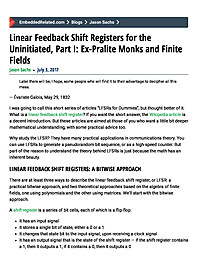
Linear Feedback Shift Registers for the Uninitiated, Part I: Ex-Pralite Monks and Finite Fields
Later there will be, I hope, some people who will find it to their advantage to decipher all this mess. — Évariste Galois, May 29, 1832 I was going to call this short series of articles “LFSRs for Dummies”, but...

C to C++: 3 Reasons to Migrate
I’ve recently written several blogs that have set the stage with a simple premise: The C programming language no longer provides embedded software developers the tools they need to develop embedded software throughout the full software stack....
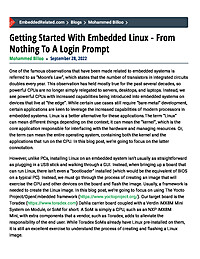
Getting Started With Embedded Linux - From Nothing To A Login Prompt
One of the famous observations that have been made related to embedded systems is referred to as “Moore’s Law”, which states that the number of transistors in integrated circuits doubles every year. This observation has held mostly true...
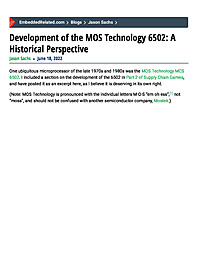
Development of the MOS Technology 6502: A Historical Perspective
One ubiquitous microprocessor of the late 1970s and 1980s was the MOS Technology MCS 6502. I included a section on the development of the 6502 in Part 2 of Supply Chain Games, and have posted it as an excerpt here, as I believe it is deserving...
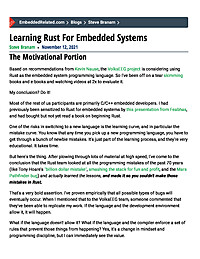
Learning Rust For Embedded Systems
The Motivational PortionBased on recommendations from Kevin Nause, the VolksEEG project is considering using Rust as the embedded system programming language. So I've been off on a tear skimming books and e-books and watching videos at 2x to...
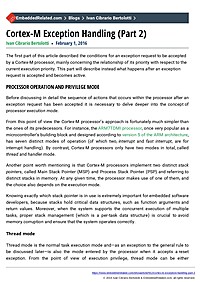
Cortex-M Exception Handling (Part 2)
The first part of this article described the conditions for an exception request to be accepted by a Cortex-M processor, mainly concerning the relationship of its priority with respect to the current execution priority. This...
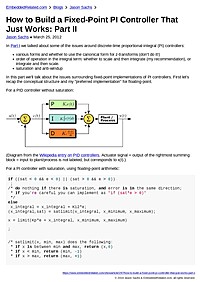
How to Build a Fixed-Point PI Controller That Just Works: Part II
In Part I we talked about some of the issues around discrete-time proportional-integral (PI) controllers: various forms and whether to use the canonical form for z-transforms (don't do it!) order of operation in the integral term: whether to...
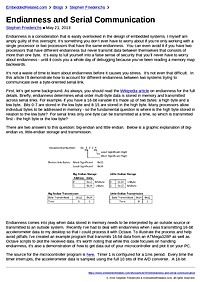
Endianness and Serial Communication
Endianness is a consideration that is easily overlooked in the design of embedded systems. I myself am amply guilty of this oversight. It’s something you don’t ever have to worry about if you’re only working with a single...
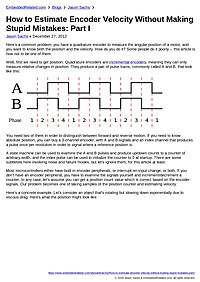
How to Estimate Encoder Velocity Without Making Stupid Mistakes: Part I
Here's a common problem: you have a quadrature encoder to measure the angular position of a motor, and you want to know both the position and the velocity. How do you do it? Some people do it poorly -- this article is how not to be one of...
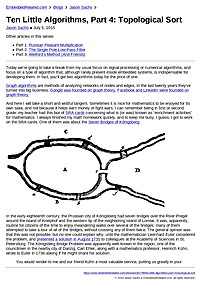
Ten Little Algorithms, Part 4: Topological Sort
Other articles in this series: Part 1: Russian Peasant Multiplication Part 2: The Single-Pole Low-Pass Filter Part 3: Welford’s Method (And Friends) Today we’re going to take a break from my usual focus on signal processing...



















